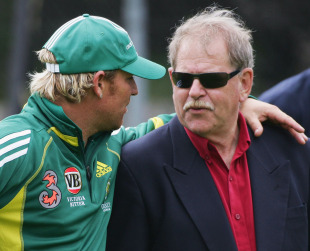Terry Jenner

|
|||
|
Related Links
|
|||
JENNER, TERRENCE JAMES, died on May 24, 2011, aged 66. Terry Jenner rode the wheel of fortune through all its vagaries and reached the satisfaction of lasting achievement. Nearly failed state cricketer who ultimately achieved a distinguished record, occasional Test player, brash competitor who reflected on the subtleties of leg-spin, convicted criminal, revered coach and the soul of active charity: his life was his own version of Shakespeare's seven ages of man, culminating in his staring-down of death. Jenner's cricketing memorial will be his deeds and words in saving the arts of spin bowling from being swamped by the deluge of speed.
After a childhood at Corrigin, in the central wheat-belt region of Western Australia, he quickly gained the notice of the state selectors when he moved to Perth. Following his debut a month after his 19th birthday, four seasons in the state side produced 34 wickets at 59, and an understanding of why the term "Western Australian leg-spinner" is an oxymoron. In 1967, Jenner and his close friend and spinning companion Ashley Mallett moved to Adelaide in search of a culture which understood and supported slow bowlers. The effect was immediate: 23 wickets at 25.82 in his first season for South Australia, and the gradual refinement of his skills. He throttled back on his speed and the amount of turn he was seeking, adding instead the seductiveness of flight and the discipline of control.
Jenner made his Test debut in the Ashes opener of 1970-71, but the pattern of his international career was laid out when he sat on the sidelines until the final game, at Sydney. There, the bare-headed Jenner ducked into a legitimate short ball from John Snow and had to be assisted from the field. What is mostly forgotten is that he returned next day to gamely add another 22 - and bowled steadily in the match to take four for 81 in 37 overs. Speed was the attack weapon of Australian cricket's renaissance under Ian Chappell in the early 1970s, and Mallett became the duty slow bowler, his off-breaks deemed more likely than Jenner's leg-spin to keep the batsmen on a tight rein if and when the quicks were rested. So Jenner was confined to nine Tests in four series spread over five years, plus four matches against the World XI in 1971-72; nevertheless, he played an important role in victory in the West Indies in 1972-73, the second of two outings at Port-of-Spain producing a career-best five for 90. In addition, his batting was a mixture of truculence and textbook: at Adelaide in the 1974-75 Ashes, his rousing 74 helped resuscitate 84 for five into 304 after Derek Underwood had threatened mayhem on a drying pitch. When he retired in 1976-77, Jenner had taken 259 wickets at 29.85 in 77 matches for his adopted state; he is one of only five South Australian players to have completed the double of 2,000 runs and 200 wickets.
Jenner was widely known to enjoy betting in many forms, but the darker side of addiction was revealed when he was arrested in 1985 for stealing from his employer in order to cover his debts. Described by his trial judge as "a pathological gambler", Jenner was sentenced after a repeat offence to six and a half years. With remission for good behaviour, he was released after 18 months in March 1990.
Thus began the most substantial and inspiring period of Jenner's life. His ability to watch, analyse, communicate and, above all, listen, made him a consummate coach and teacher: Australian wicketkeeper Ian Healy dubbed him "The Spin Doctor". He was most famously associated with Shane Warne, who responded enthusiastically, describing him as "the best spin-bowling coach around and daylight is probably second". Jenner was well aware of the dictum of Wilfred Rhodes - "If batsman thinks I'm spinning 'em, I'm spinning 'em" - and the blarney of the slider and the zooter became an important part of the psychological armoury he cultivated. Importantly, though, his influence reached beyond the megastar to the many fledgling spinners at the Australian Cricket Academy and elsewhere. Jenner's charity fund-raising, his media commentary and his flair as compe`re and after-dinner speaker completed a process of restitution and rehabilitation, seen in his involvement in the 1998 celebrations of the golden jubilee of the 1948 Invincibles and the unflinching account of his life in T. J. Over the Top - Cricket, Prison and Warnie, written with Ken Piesse in 1999.
In April 2010, he suffered a catastrophic heart attack, which left him with just 15% cardiac capacity and a brief life expectancy. Although a shadow of his former self, Jenner survived for over a year, and was present at a testimonial in Adelaide in October 2010 at which colleagues and friends spoke with passion. Ian Chappell, his state and national captain and staunchest of friends, commented after Jenner's death: "He was a lively but honest team-mate. He could be great company or a pain in the arse, but you always knew where you stood with Terry, and if you had a disagreement it was sorted out and then forgotten. Most of the disagreements were over him not bowling enough, and it's hard to stay mad at a player who wants to get more involved. He was a terrific coach because he could see a problem and then tell the player how to fix it, and he'd do it in a way that was easily understood." As Jenner himself stressed, he could not have achieved this success without the unstinting support of a large group of friends but, most particularly, that of his partner, Ann Blair, and his daughter, Trudianne.

